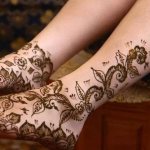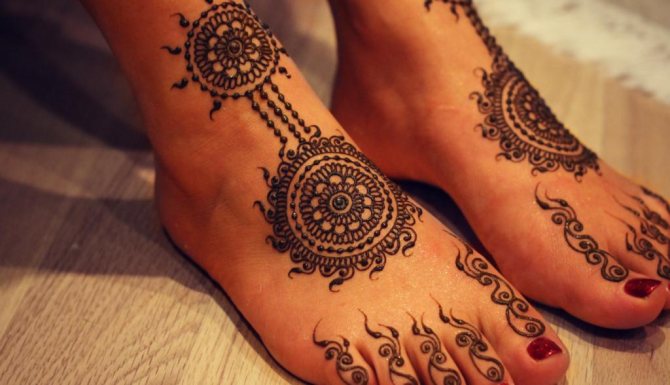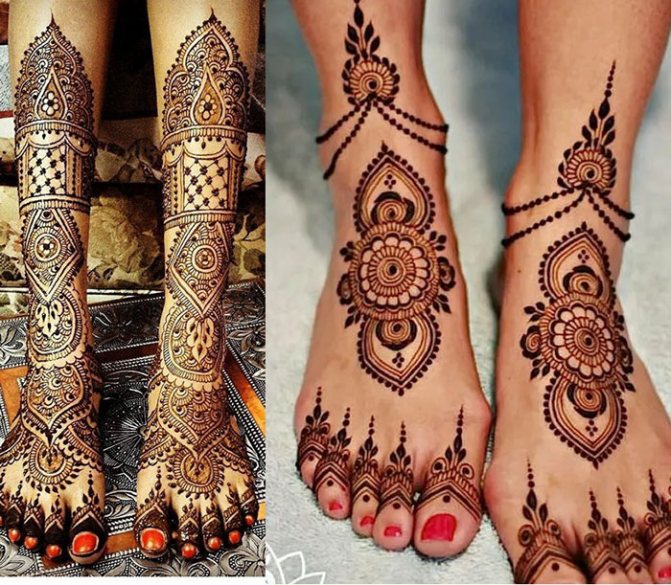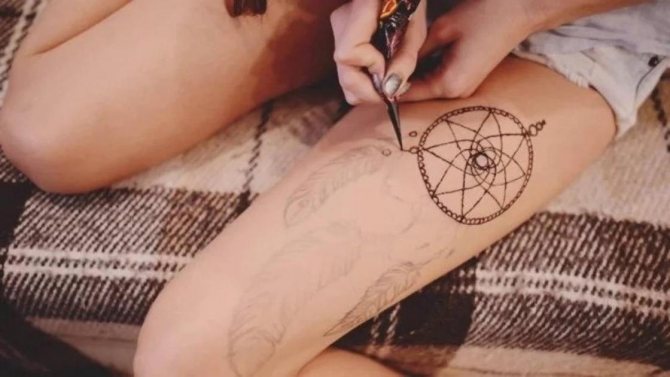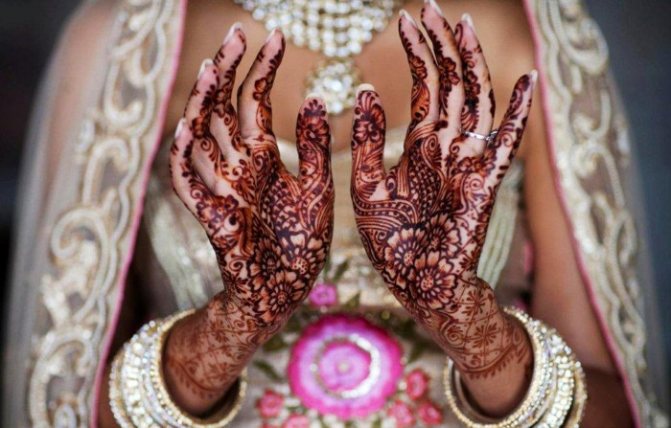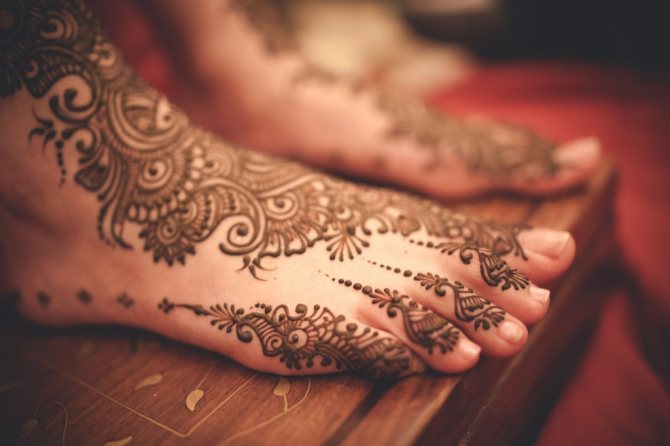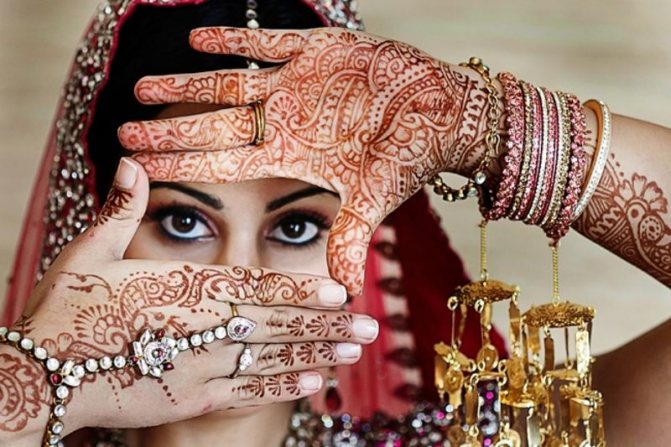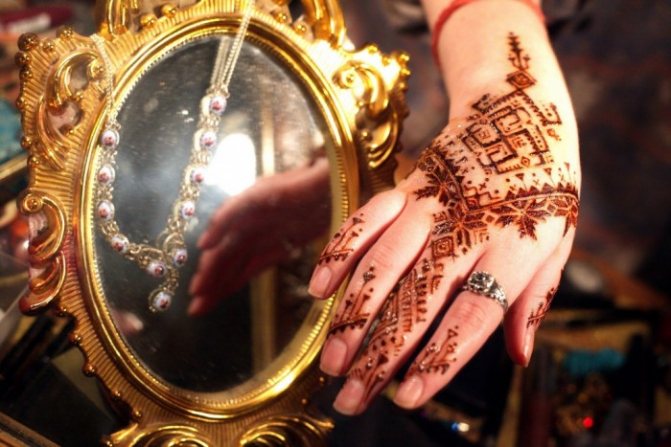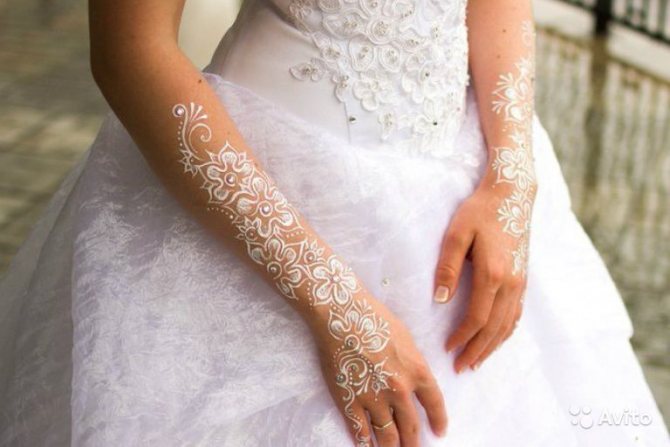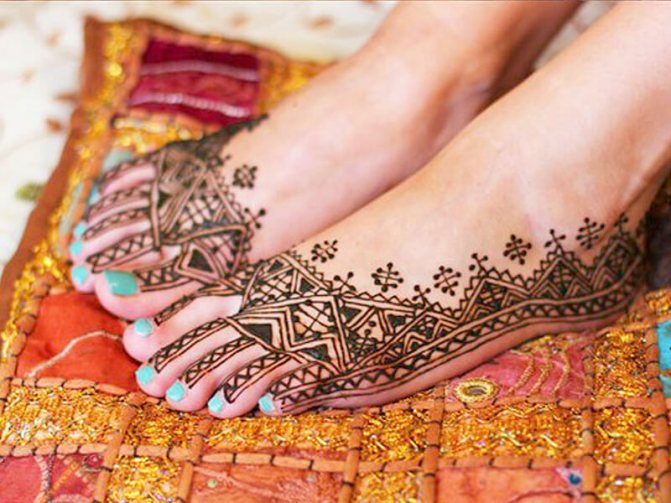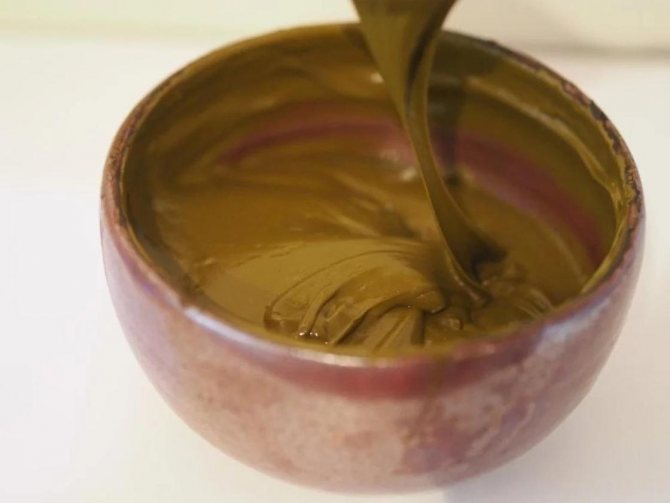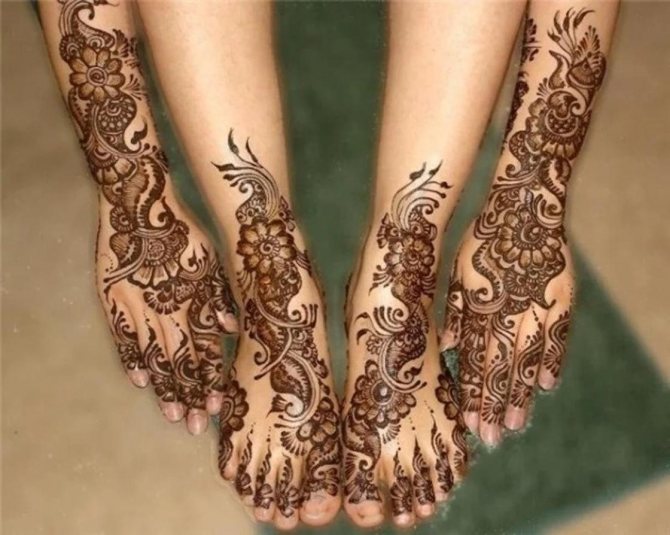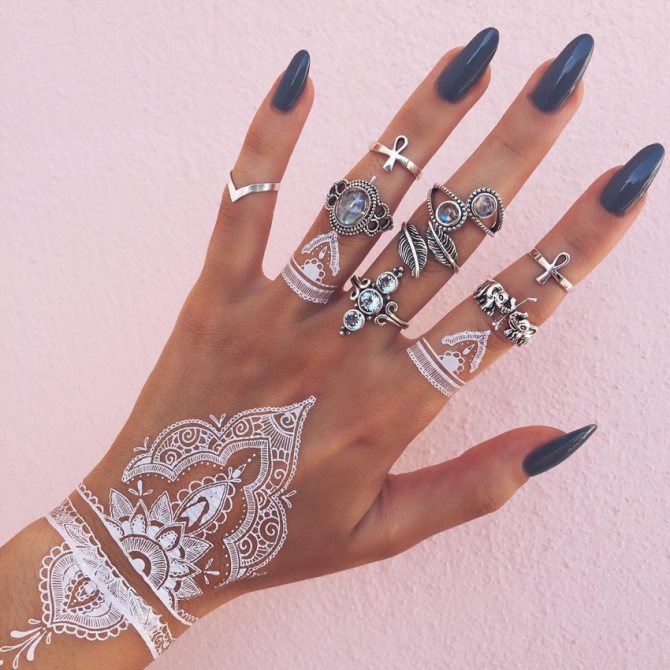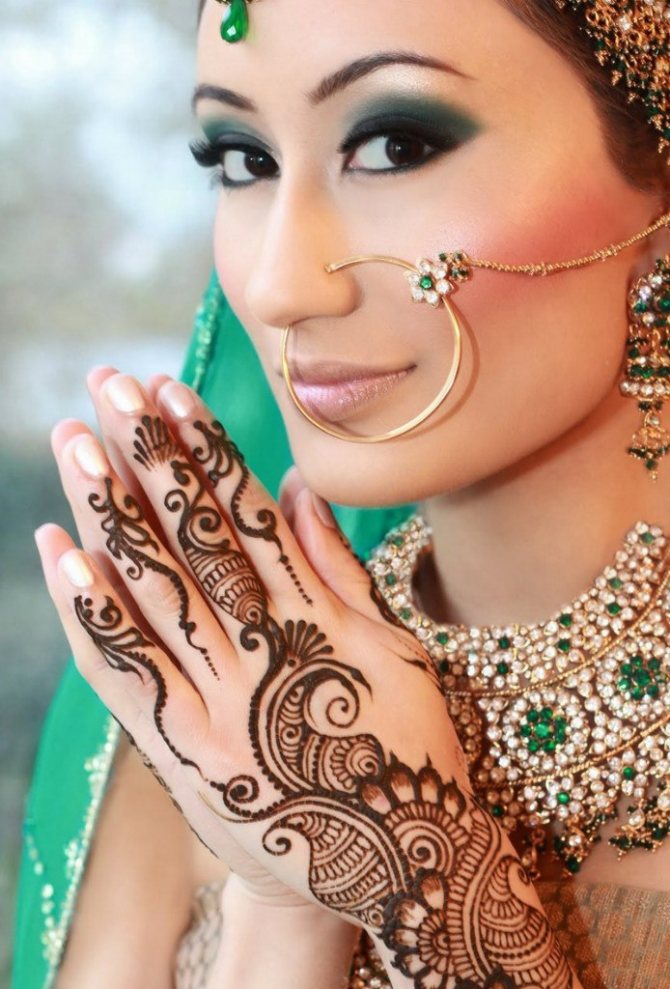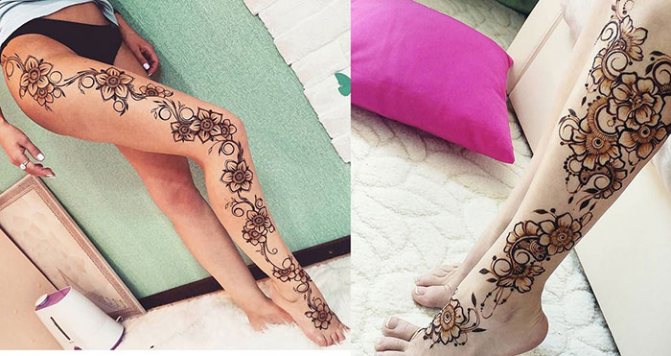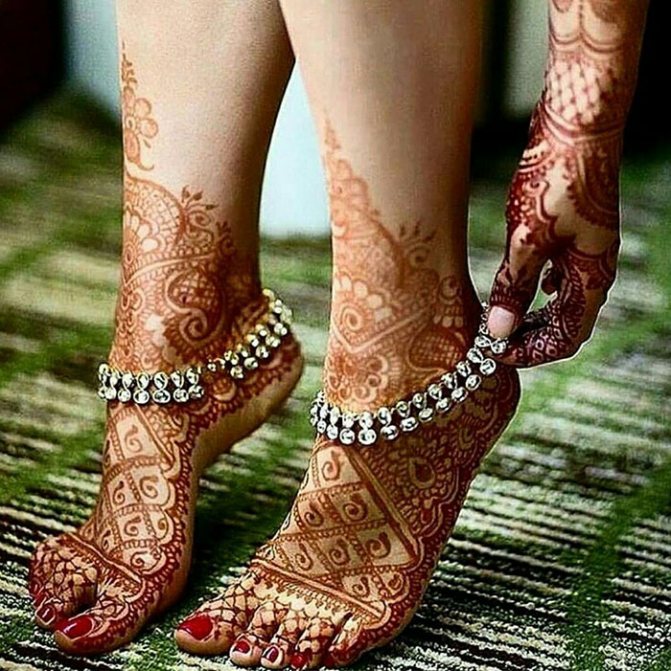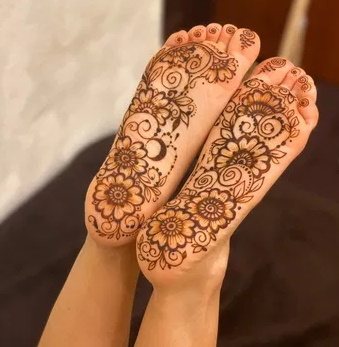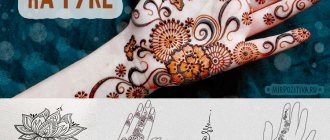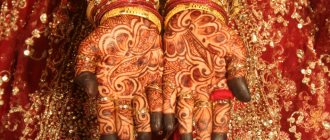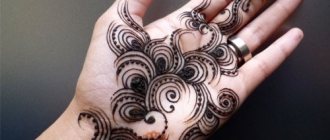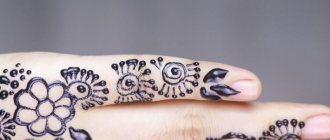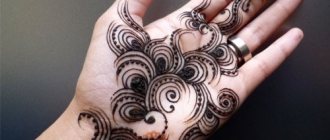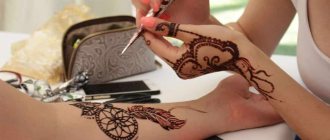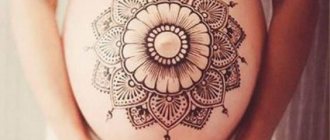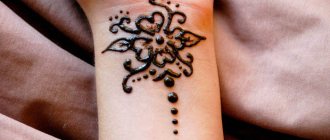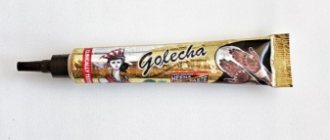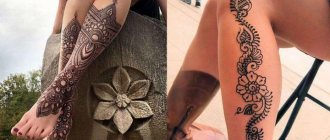Photo: UGC Temporary henna tattoo - a great alternative to the traditional drawings on the body, which are applied with ink. In the spring and summer period, when girls are shifting into sandals and wearing light dresses, mehendi on the leg becomes especially relevant. Let's look at the technology of this process and what images are trending in 2018.
History of origin and distinctive features of the style
Mehendi is a body drawing made by henna, which is traditionally done to girls in India, but today this type of temporary tattoo has become popular in all parts of the world. Experts are at a loss as to which country is considered the first to start doing mehendi.

The only thing they agree on is that the origin of the body decoration has Arabian roots and the first mention of it was already more than 5 thousand years ago. At that time, only the nobility could afford a luxurious pattern on the body. The painting is often associated with the traditional aspect. For example, in India, mehendi is made to brides before the wedding day.
Drawing on the hands and feet of the girl is supposed to bring happiness to the girl in her married life and protect her from evil spirits.
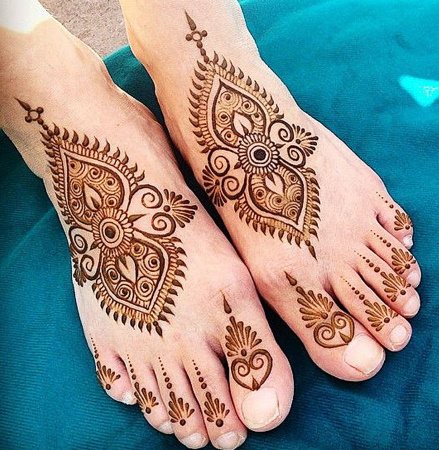

Gradually, drawing became very popular in Europe as well. Here it lost its sacred meaning, but acquired new styles of images. However, most girls prefer to draw on the body in the traditional oriental style.
Mehendi for Men on the Arm
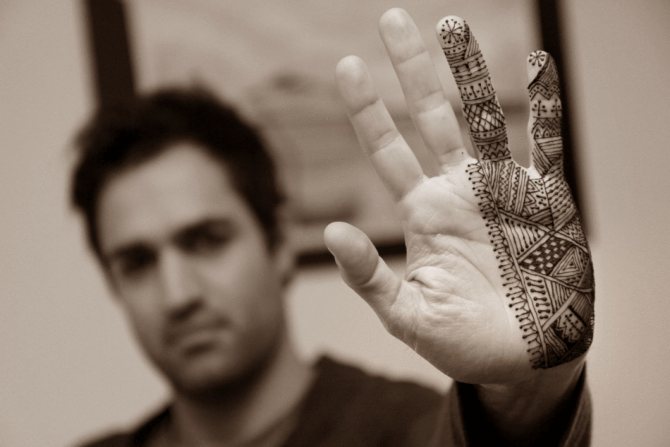

Mehendi for Men on Hand Mehendi for Men on Hand
The most ardent fans of the art of mehendi are considered to be women. They love to transform their bodies with such beautiful ornaments for various kinds of events, vacation trips, photo shoots and even weddings.
However, in addition to women, men can also decorate their bodies with beautiful drawings with meaning. For them in the collection of mehendi also find patterns and ornaments that emphasize their strength, courage, dignity and heroism.
Tools and medium for painting
It is possible to do a henna body painting at home, as long as you have all the necessary tools.
| Tools | Purpose |
| A henna-based dye | Some people use several shades of dye at once to create a colored henna pattern. Masters of mehendi drawings recommend buying a ready-made mass that already has a nozzle or shape with a narrow tip that adjusts the thickness of the dye. |
| Leather oils | Makes the pattern more durable. |
| Lint-free cloths. | These are used to remove the dried up paint. |
| Stencil for beginners | Special stencils for mehendi have a sticky layer, that's why they don't move down and give an opportunity to create an even drawing. |
| Alcohol or lotion | For degreasing the surface of the skin. |
| Scrub or peeling | To remove burrs. |
| Food grade foil | Wrap the finished pattern to allow the henna to penetrate deeper into the skin. |
Drawings for beginners
For beginners, it is better to choose simple drawings. If you prefer complex images, buy a stencil.
Simple Sketches.
Simple options include images of the sun, leaves. The novice artist will suit abstract patterns. The complexity of the drawing the master will be able to choose individually. The picture in this case will look stylish, original.
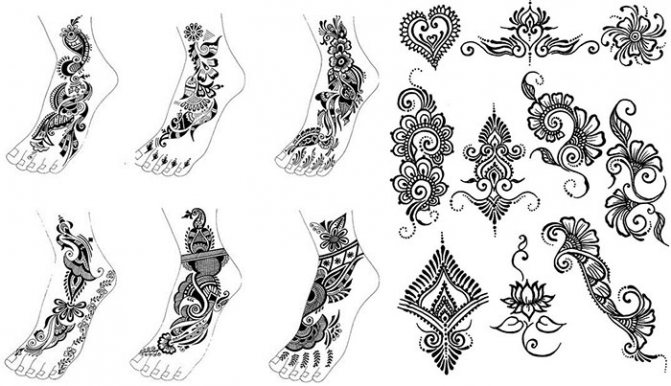

Photos of finished work
Consider the finished work can be seen in the photo. Ideas can be used when drawing your own sketch.
Types of henna for painting mehendi
You can find mehendi henna on the market as a ready-made mass or as a powder. The second is more suitable for use by professionals, because the dry form of the product is difficult to bring to the right consistency.
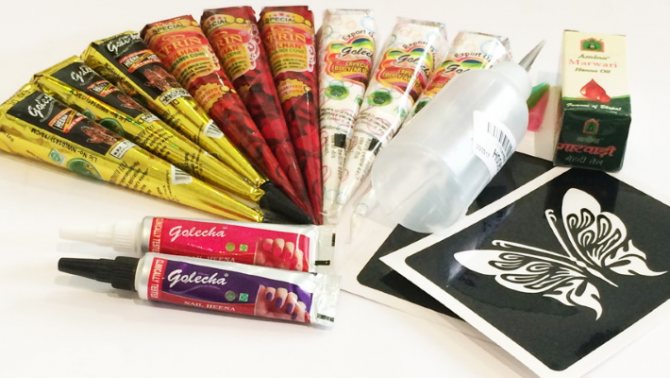

Beginners are advised to work with ready-made paste masses of henna. They are sold in tubes with a narrow tip or with a ready-made plastic tip. This packaging allows you to squeeze the henna in a thin stream.
Choosing henna for painting, it is important to pay attention to what composition the product has. The henna on sale is available in color or natural.
- Natural henna has a brown or red color. It is made from the dried leaves of the henna tree. When opened, the paste should be soft and viscous. To choose a tube, pay attention to its elasticity and the presence of holes. Deflated packaging indicates that air may have entered and the paste may have solidified.
- Colored paste is made by adding chemical dyes. Such a product can have almost any shade, it is sold in tubes or jars. It is more common to be allergic to such henna than to natural henna. Therefore, it is recommended to conduct a sensitivity test before using the product. It is recommended to choose a product with more natural components.
On how fresh the product depends on its dyeing properties. Sellers do not always keep the correct shelf life, but the buyer can always check with what the expiration date of the product.
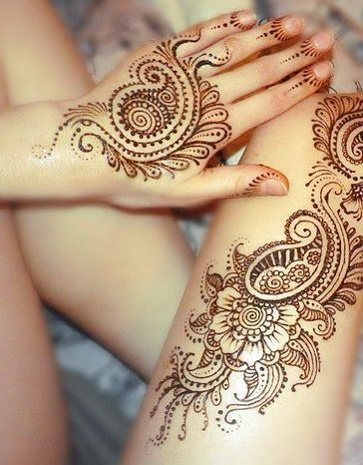

Natural henna, without chemical additives, has an average shelf life of about 1 year, but only in the first 3 months of use (subject to storage conditions) it will show up brightest on the skin. Colored henna retains its coloring properties longer and can be kept hidden longer.
Also take into account the fact that individual skin features can affect the color of the pattern. The dye may appear brighter or paler. Natural henna on light skin tones may take on a red hue instead of brown.
How to prepare the paint at home
Mehendi on the leg or other parts of the body is drawn with henna, which is sold as a powder or ready mix. If you choose henna in powder form, you need to knead the desired mass.
- Pour 500 ml of boiling water in a vessel with 3 tsp. of black tea.
- Brew the mixture for 5-10 minutes, then strain the ready liquid.
- Add 40 g of henna powder and stir continuously until a homogeneous pulp.
- Add 1 tbsp. lemon juice and a few drops of essential oil (preferably eucalyptus oil).
- The mixture is prepared to leave in the cold for 3-4 hours. During this time, the mixture should thicken and acquire a consistency similar to sour cream.
Such henna mass can be stored for more than 2 weeks if the package remains airtight.
What styles can be performed
Over the course of the art's existence, several regional currents have developed.
Plant and floral motifs
The floral motifs are preferred by the inhabitants of the Arab East. The picture is applied densely. Most often a natural shade of henna is used, contrasting colors are less popular.
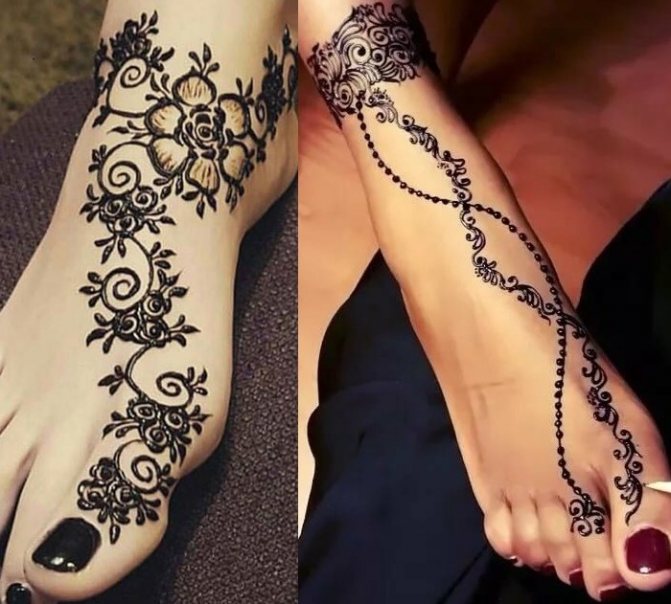

Geometric designs
Geometric patterns are characteristic of the works of African artists. The ornaments repeat the natural lines of the body, emphasizing the beauty and grace of women's legs.
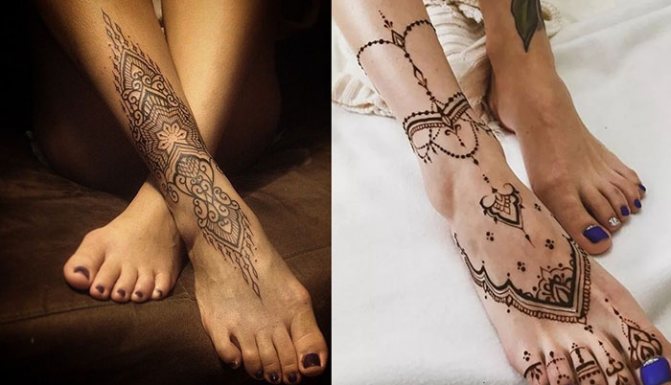

The ornament on the entire surface of the area
If the patterns occupy a large surface, reminiscent of a bracelet or stocking, the artist has followed the Indian tradition. The foot can depict birds, animals, flowers, sacred symbols. Often the ornaments are made in 2 or more colors.
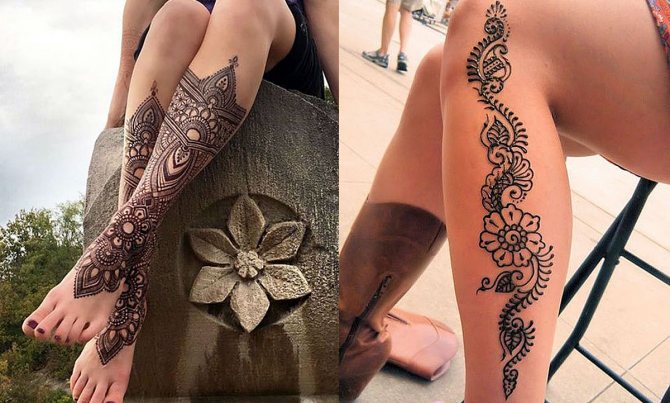

Henna on the fingertips
The tips of the toes are covered entirely with paint by the inhabitants of Asian countries. The Bedouin have a similar tradition. They paint the entire foot.
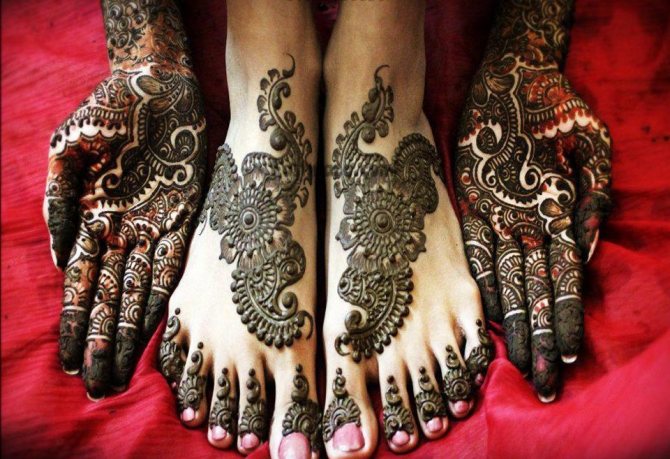

Significance of the location of the pattern on the foot
Mehendi on the foot can last from 2 to 4 weeks.Even if the skin is wet with water. After a certain period of time, the pattern itself is removed from the skin. It is most often applied on the feet or on the top of the leg, but the style of images can vary greatly.
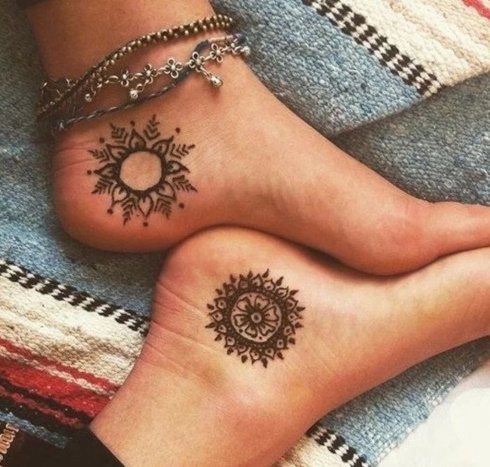

In total, there are 4 main directions of painting:
- Middle Eastern painting.. The pattern consists of a chaotic image of flowers, which are similar to the images on the Arabian embroidery. There are no blanks of the pattern, the process of creating the pattern is spontaneous.
- North African painting .. The combination of geometric fragments with connecting elements in the form of flowers. The pattern is created so that it emphasizes the curves of the body.
- Indian painting. Complex patterns can cover the entire area of the leg, creating the appearance of stockings. Such designs in ancient India have always had a hidden sacred meaning. Painting in India or Pakistan differs in the peculiarity of the pattern. Here, elements in the form of drops and the creation of a general ornament of thin lines are practiced.
- Indonesian or South Asian painting. Patterns in this style are considered the most common, because they combine elements of Indian and Middle Eastern methods of drawing.
The variety of types of painting allows you to decorate your body with any pattern you like. Before you start creating a drawing, it is worth determining what kind of pattern it will be. Each pattern has its own specific meaning.
| The pattern | Interpretation | Place | Interpretation |
| 8-square | All-round protection. | Leg | Right - search for inner values. Left - knowledge of one's life path. |
| Vine | Loyalty, devotion. | Foot | Right - selfishness, forced companionship. The left is a lack of support from loved ones. |
| The image in the form of a disk. | In a woman, chastity. In a man, masculinity. | Shin and ankle. | Meaning depends only on the pattern chosen. |
| Grains | Abundance in everything | ||
| Stars | Reliability and confidence, reference to the divine, protection of the patron. |
Meaning of the mehendi symbols: pictures and writings
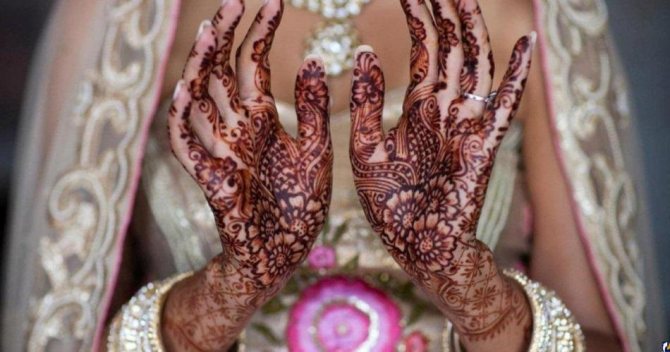

Meaning of the symbols of mehendi drawings
- There are four main styles of mehendi drawing. The difference between them lies in the places where they are distributed
- The fact that in the Middle East it is more common to draw floral motifs. Such drawings are somewhat reminiscent of Arabic embroidery. Their execution is more spontaneous, and never responds to any sketches or molds
- North African mehendi, as a rule, are drawn in the form of geometric figures with floral motifs. Such drawings must necessarily repeat the shape of the body on which they are performed
- Pakistani and Indian craftsmen do not stop only at the palms and feet of people acting as canvases. They stretch the drawings much higher, thus creating a kind of stocking or gloves woven from their drawings. Indian-Pakistani mehendi combine drop designs, ornaments and flowing lines
- Indonesian and South Asian mehendi have absorbed something of the ornaments of the Middle East and India
Here are some of the meanings of mehendi drawings:
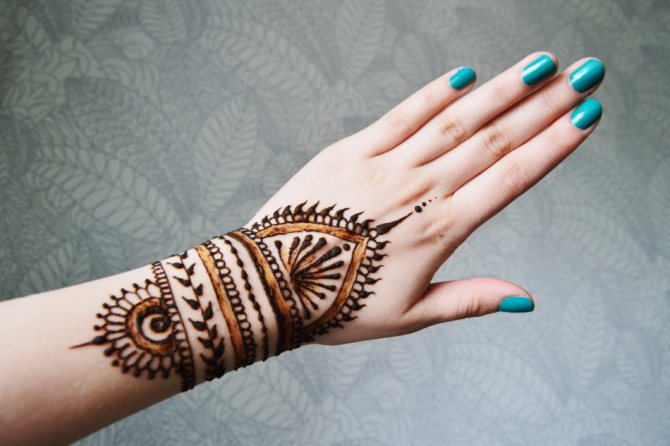

Bracelet - a pledge of success in love affairs
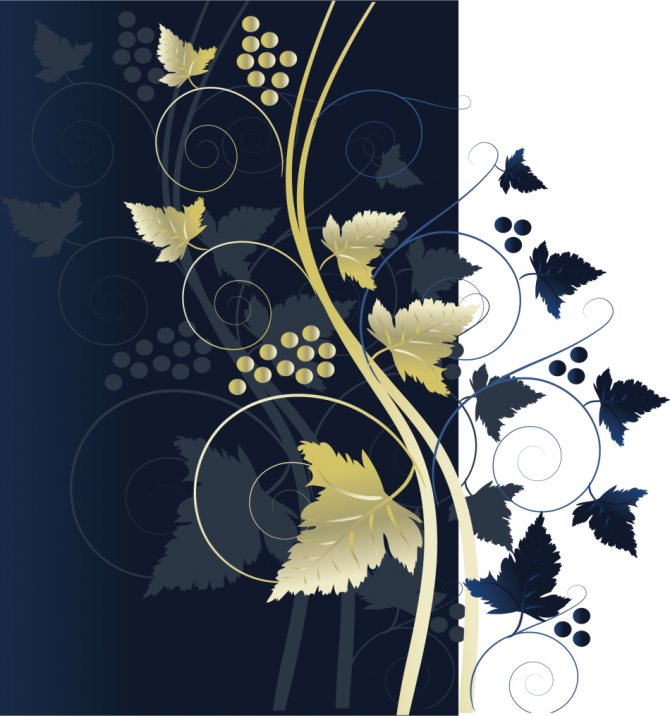

Vine - loyalty and devotion
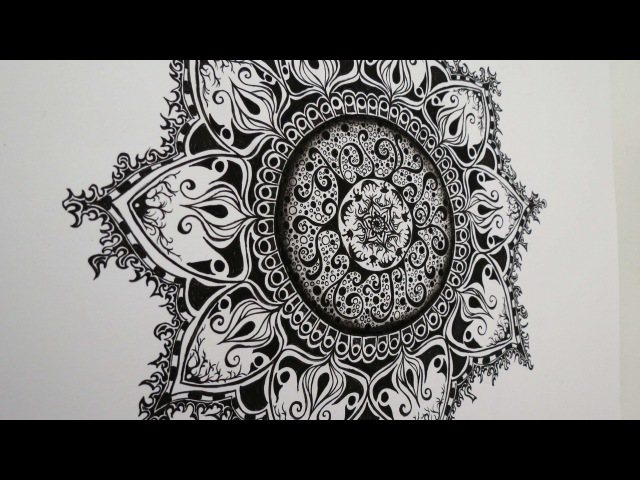

Octagon - protection from all four sides of the world, including mixed directions
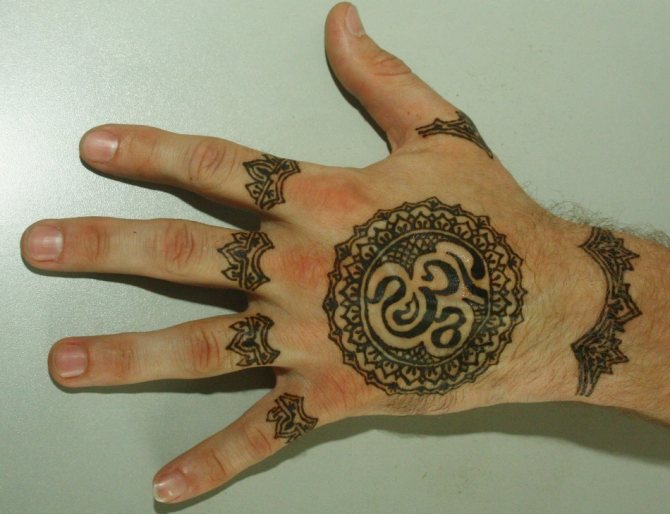

Disk for representatives of stronger sex - domination over others, sign of masculinity
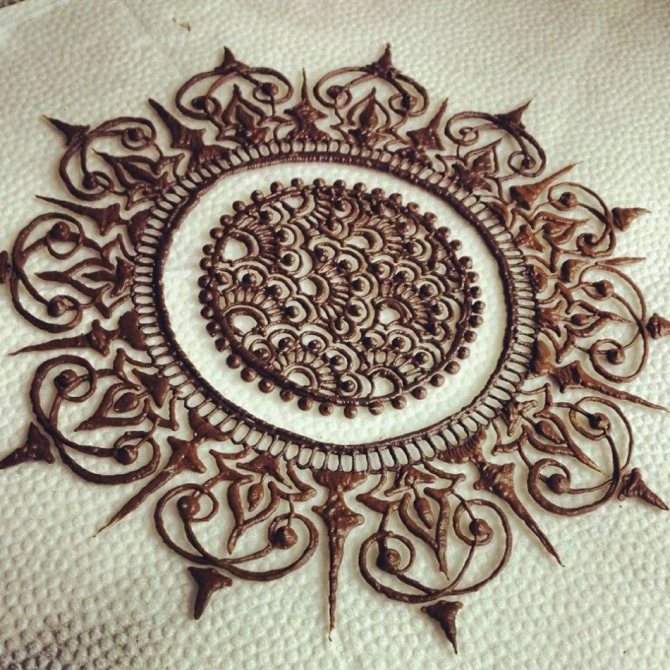

The disk in the fair sex is a symbol of chastity.
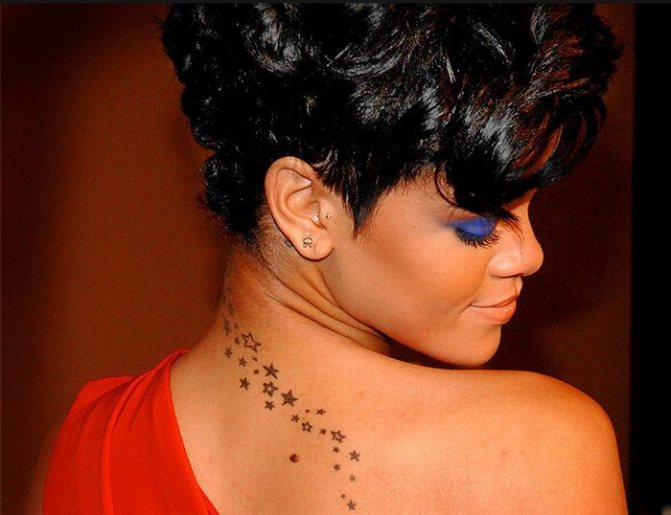

Five-pointed star - symbol of five elements
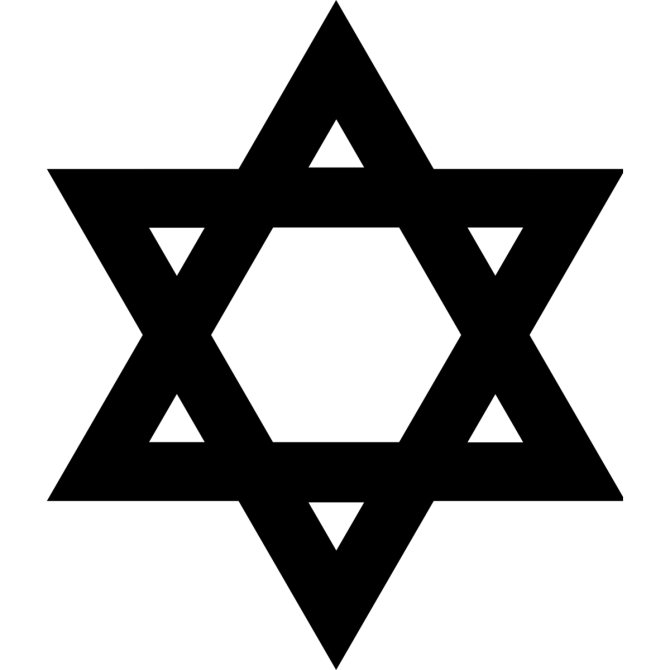

Six-pointed star - harmony between a man and a woman


Star - divinity and hope
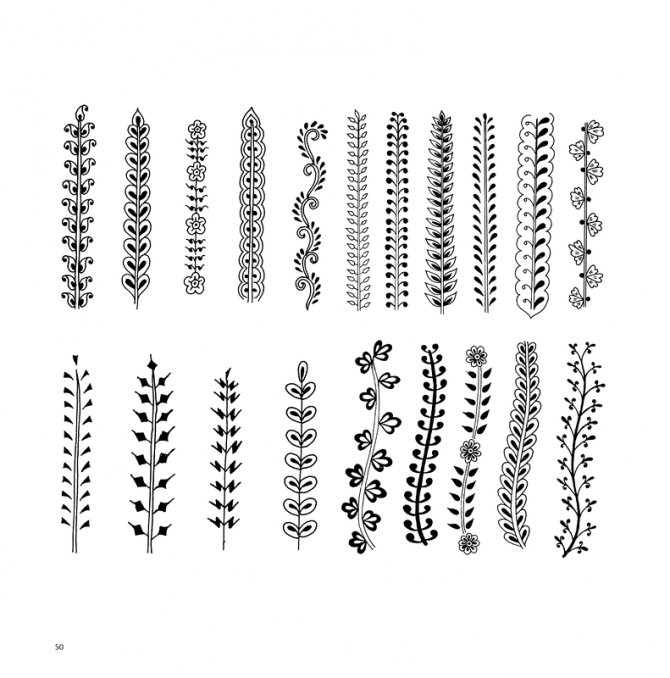

Grain - symbol of plenty
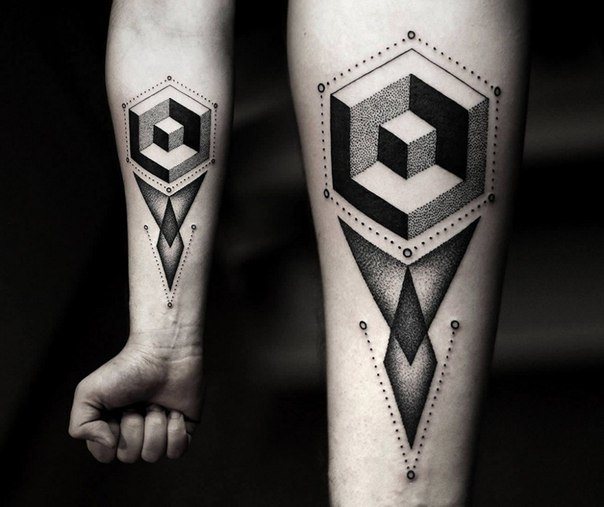

Square - symbol of honesty and constancy
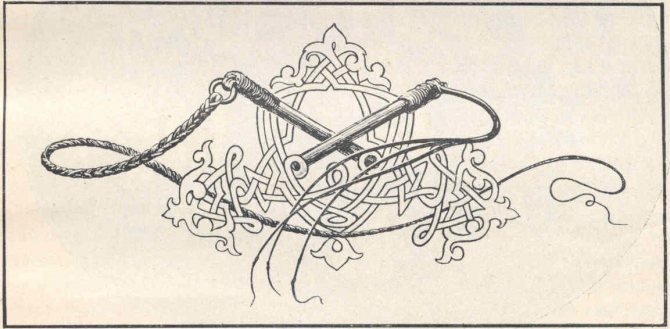

The whip - self-confidence and serenity
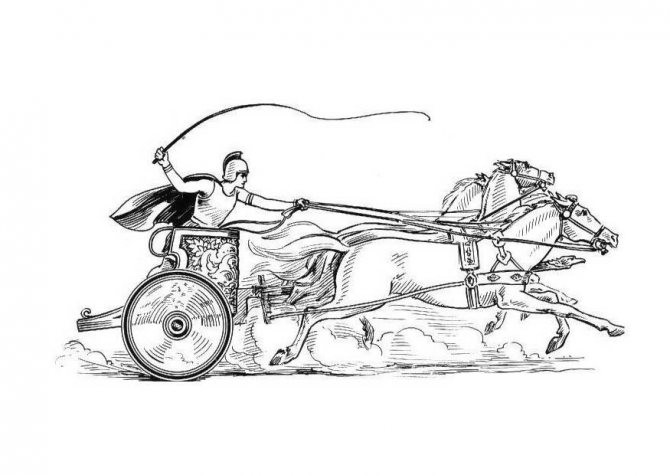

Chariot - great knowledge and good mental development
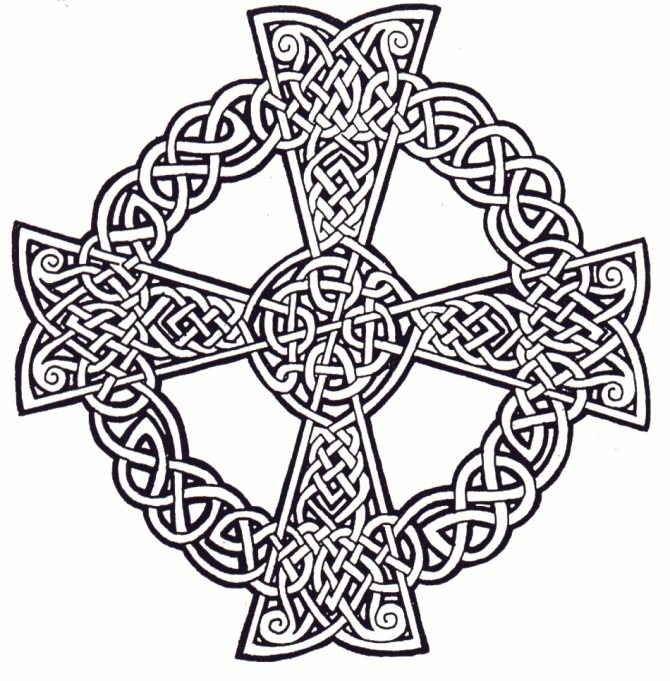

Cross - connecting link between heaven and earth
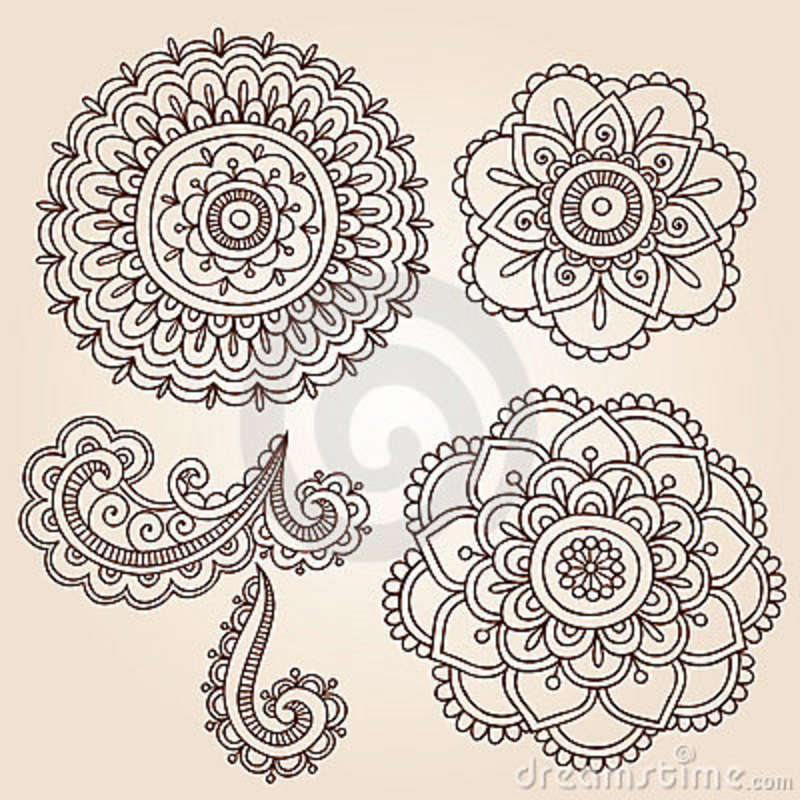

Circle - one coil of life
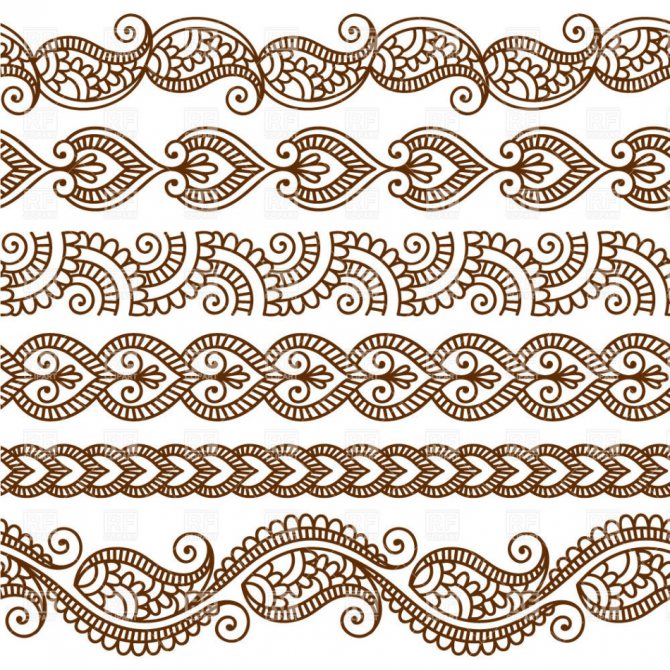

Curve - good luck, overcoming obstacles, career advancement
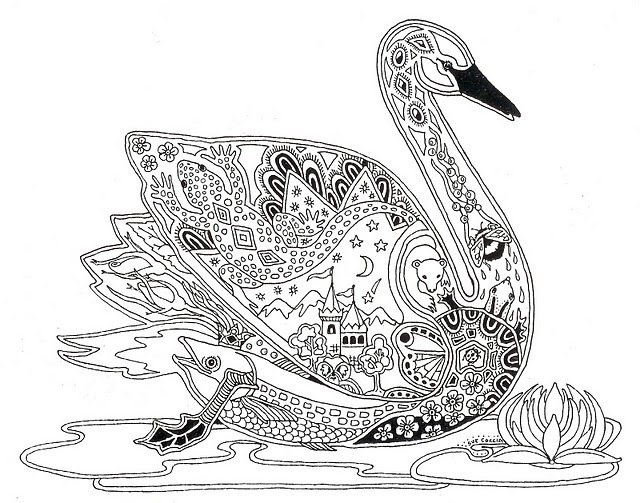

Swan - success
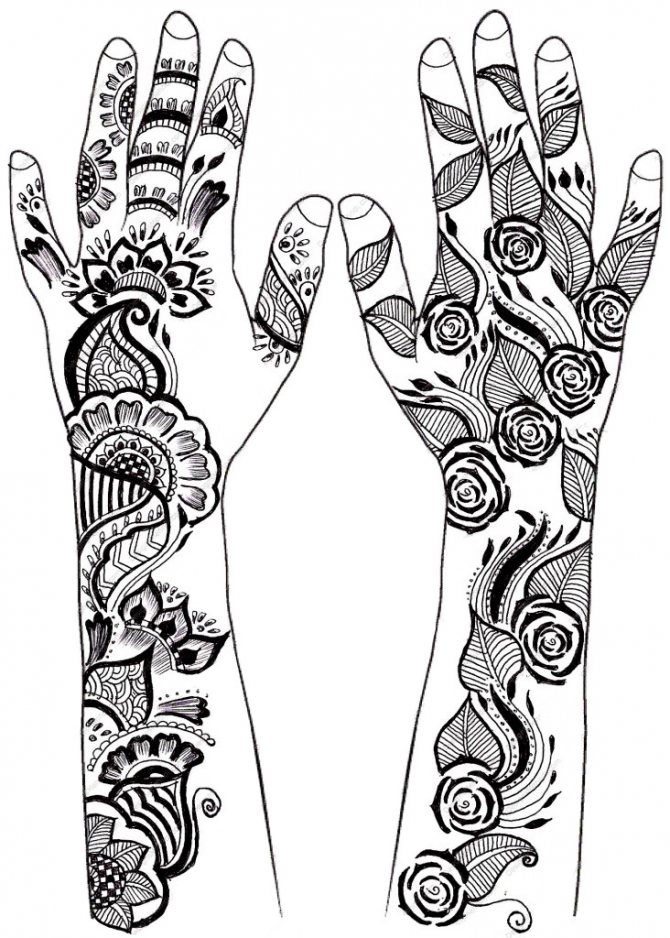

Liana - determination, which helps to achieve success
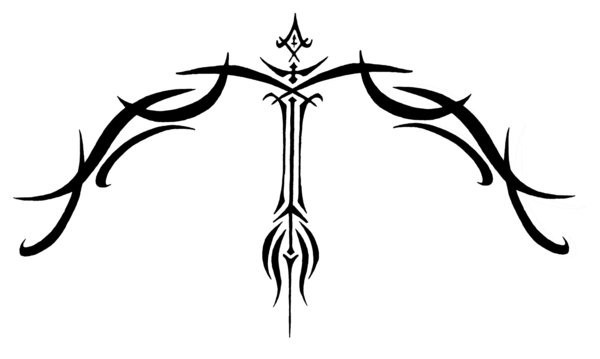

Bow with arrow - happiness in personal life, overcoming difficulties
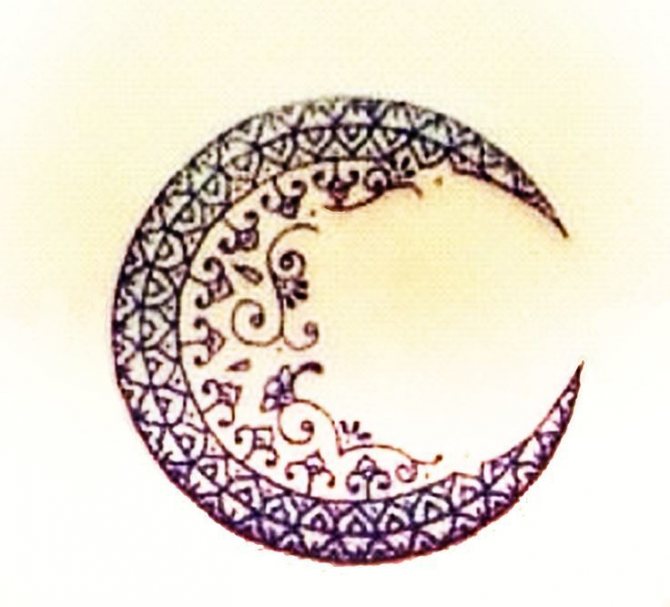

Crescent Moon - stunning beauty
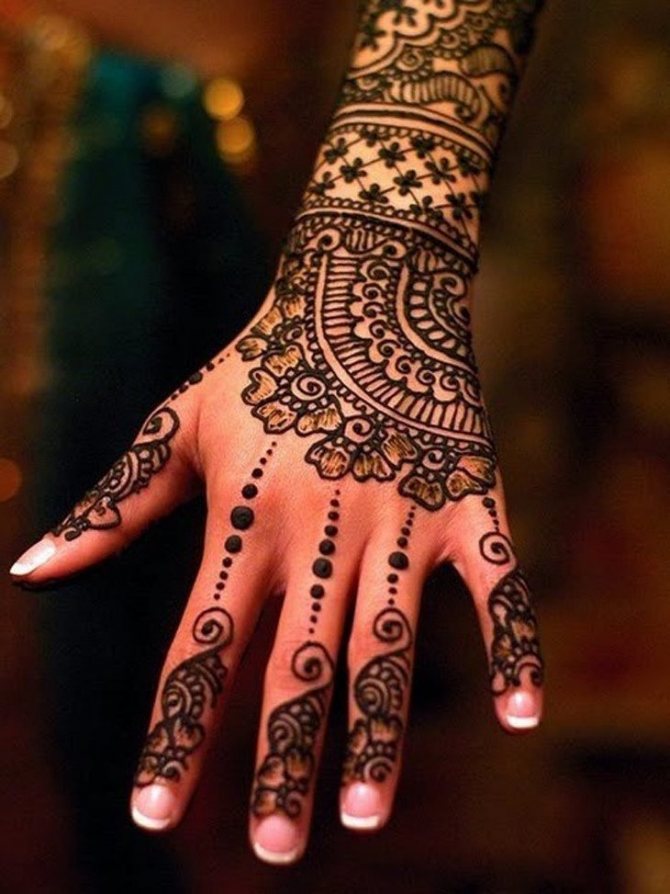

Little dots - a sign of the love a woman feels for her spouse
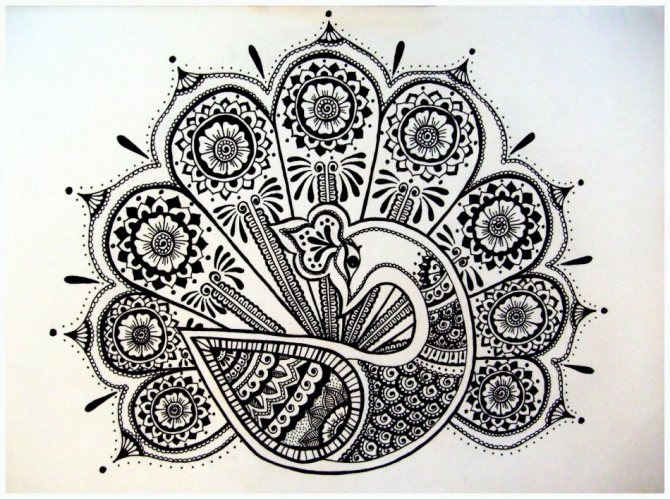

Peacock - passion, love, desire
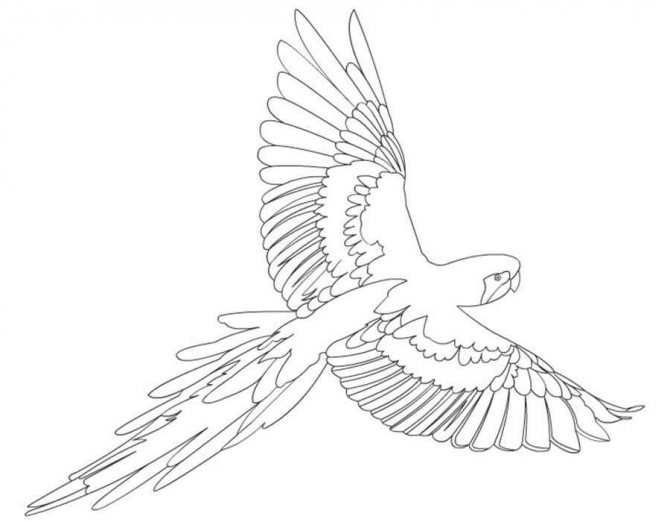

Parrot - a messenger
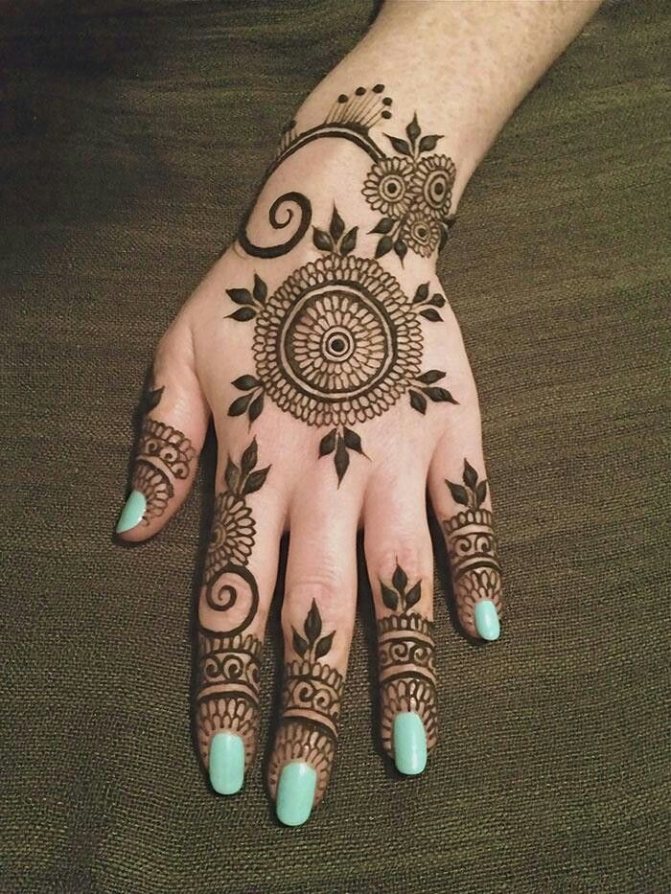

Shell - protection from all ills, a symbol of victory
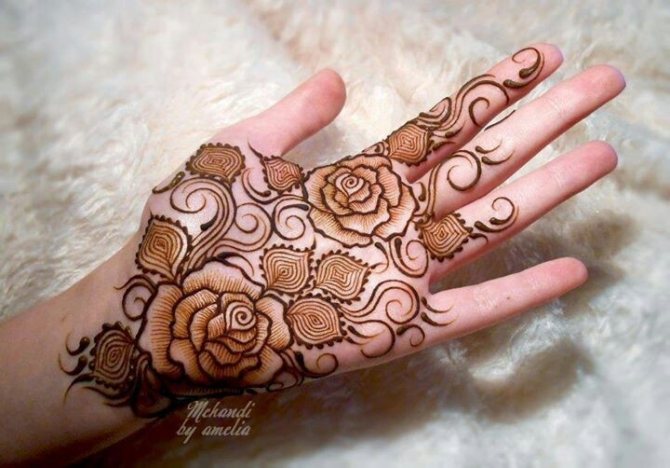

Rose, a symbol of chastity
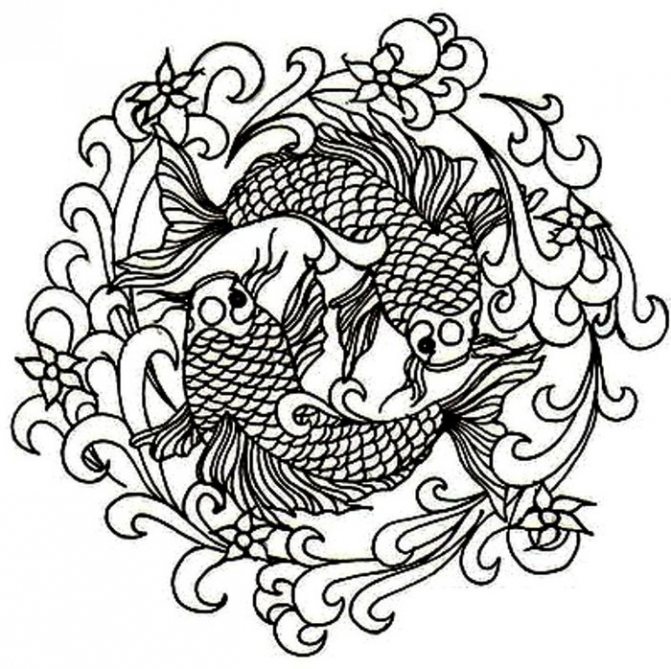

Fish - passion
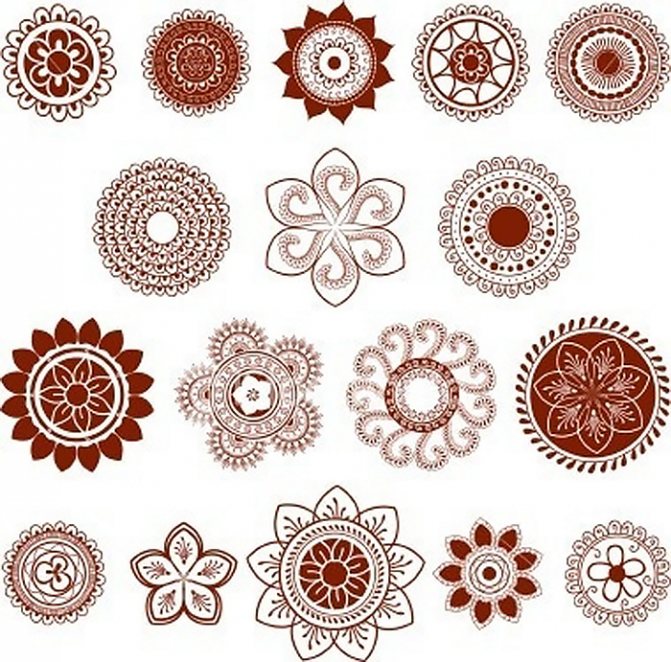

The Sun - gateway to the world of knowledge and eternal life
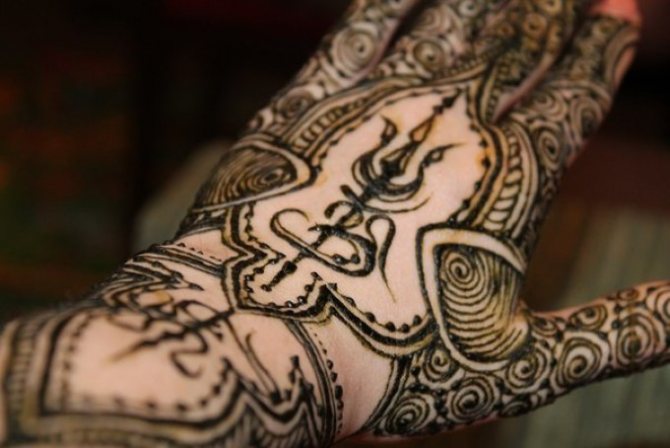

Trident in men - courage, bravery and heroism, Trident in women - maternal origin, female inner strength, energy
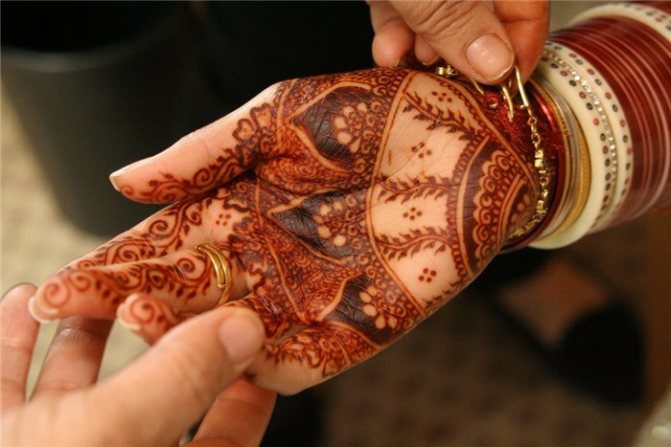

Triangle - totem from natural disasters, diseases and worries
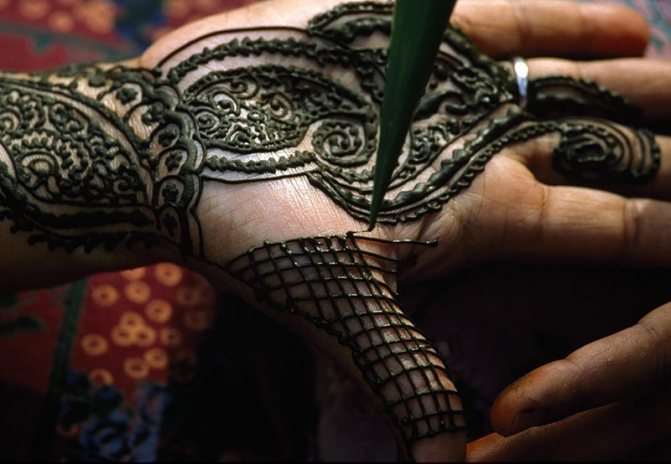

Flag - symbol of well-being and home
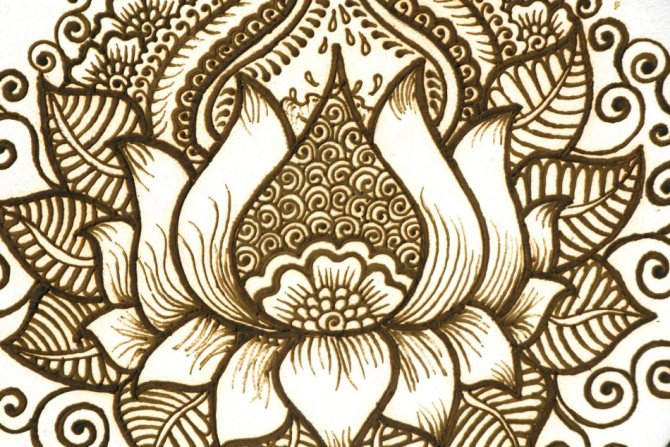

Lotus - good luck charm
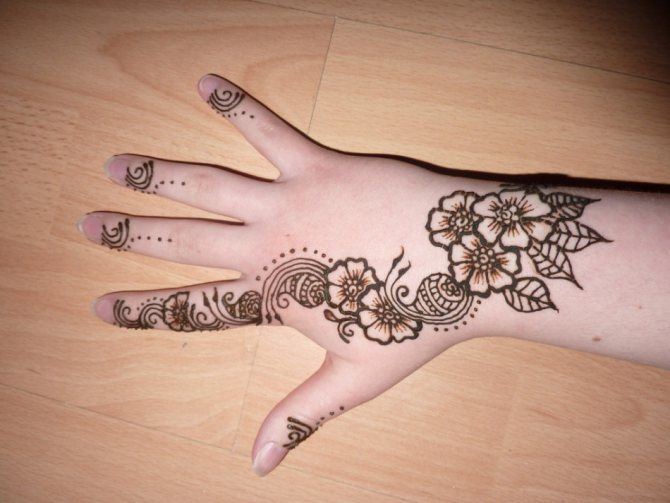

Flowers - new life
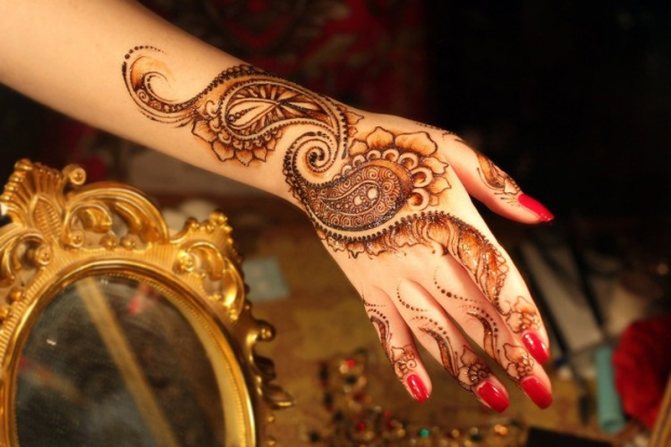

Cucumber - sign of development, energy, happiness, prosperity and immortality
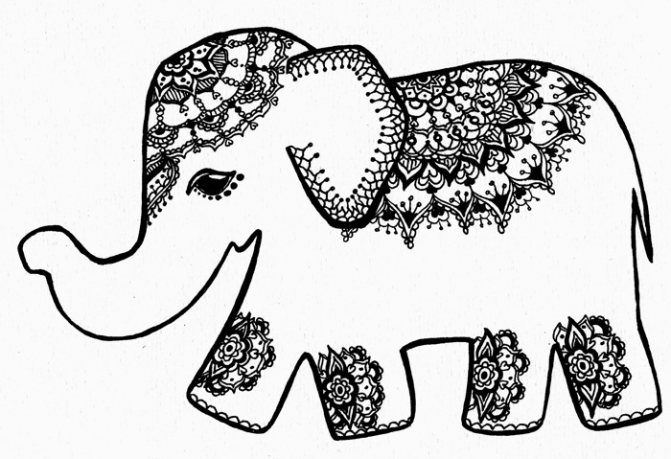

Elephant - strength, power, dominance, intelligence, dignity, fertility, immortality, happiness, and comprehensive goodness
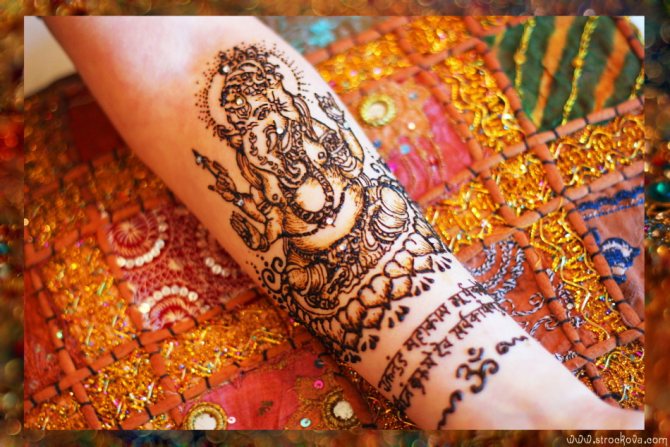

Sri Ganesha a symbol of wisdom, kindness and prosperity
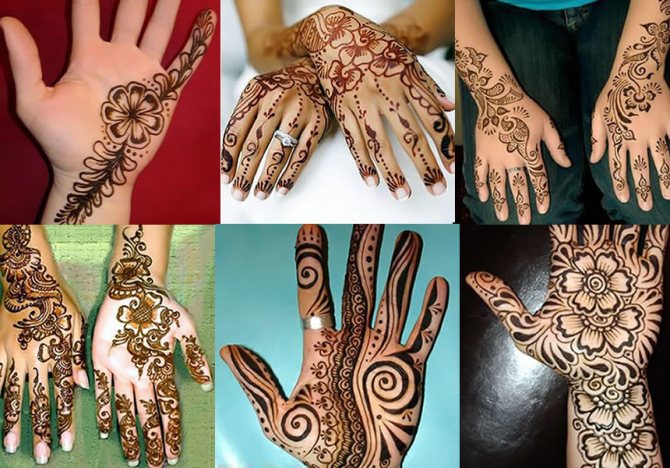

Spiral - symbol of self-knowledge
Applying Technique
Mehendi on the leg accurately and in a short time can be done even by beginners. To do this, you should carefully study The step by step instructions and adhere to its stages.
- Sometimes henna can cause an allergic reaction, so in order to avoid unpleasant results, a test for reaction in advance. A small amount of the mixture is put on the bend of the elbow, from which the pattern will be created, and wait for about half an hour. If the skin is not red and there are no unpleasant sensations, it is possible to proceed to the process of drawing.
- The skin surface where the picture will be done, should be prepared beforehand to make mehendi last as long as possible. First remove the horny layer of skin with scrub, then remove sebum with alcohol.
- It is desirable to remove hairs from the place prepared for the application of the pattern.
- For the mass to lie evenly, not to flow and create a neat pattern, the skin is treated with eucalyptus oil.
- If you are not sure that the pattern can be drawn by hand the first time, it is advised to use a stencil or draw a sketch on the skin with a pen.
- In the first place, create the largest details of the drawing. Then fine lines and elements are drawn.
- During the creation of the pattern, make sure that the thickness of the henna does not exceed 2 cm, otherwise the pattern will take a long time to dry.
- If mistakes were made in the process of creating the pattern, they are removed with a cotton swab.
- The finished drawing is left to dry for 60 minutes. after that time, the dried mass is removed from the skin with a special scraper. If it is not available, use the blunt side of a knife.
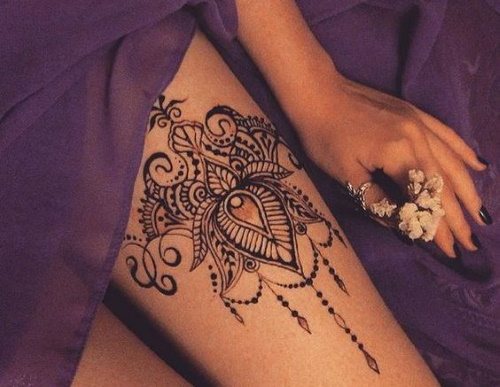

It is not recommended to often make a pattern on the same area of the skin, the time interval between the creation of the pattern should be at least 35 days. After the pattern has been made, it is important not to get it wet with water during the first 8 hours. Therefore, it is recommended that the pattern be done at night, when the risk of contact with water is minimized.
Simple Sketches
Beginners can use special stencils to create a neat pattern or depict the simplest elements.
Turkish Cucumber
Originally, this drawing was applied to the bride's body. This symbol was considered a kind of wish for happiness for the new family. The image itself in the classic interpretation denotes abundance, wealth and fertility - everything that is wished for young families.
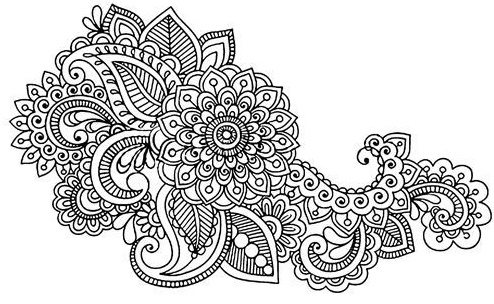

- An S-shaped line is drawn from top to bottom.
- At the tip of the top of a drop is drawn and painted.
- Connect the upper tip with the lower, draw a semicircular line on the right. So you get a drawing in the form of a drop with the tip in the form of a small drop.
- At the base of the figure inside the arc is drawn. It will be the heart of the flower.
- From the arc-core in the inner part of the drop draw a few petals (from the left side of the drop to the right).
- Between the petals draw stamens.
- On top of stamens from the left side of the drop to the right draw a line similar to the line of petals. Each curve should bypass stamen.
- On top of the wavy line draw an arc and fill this space.
- Two more arcs are drawn on top. Drawing should tend to the upper drop and gradually taper.
- Above the arc draw petals.
- Draw an inverted arc under the droplet and from it a few petals.
Another option for drawing a Turkish cucumber.


- Draw a spiral of 3 turns and the last turn take the line down.
- From the top point of the spiral lead line to the end of the line above. And on top of another one. The line should be rounded. So you get the drawing of the bent sheet.
- The space from the 1st arc to the 2nd arc is painted with a zigzag.
- Above the upper arc from beginning to end is drawn repeated element "little spiral".
- Above the spirals draw small arcs, which should cover them with soboi.
Lotus .
Eastern peoples this flower is considered a sacred plant and is depicted in many folk motifs. The meaning of the pattern may vary depending on how many petals are depicted. Most often, the lotus pattern symbolizes femininity and wisdom.
- Draw a drop with the sharp end upwards. Visually divide the drawing in half and at this level draw a point on the right and left.
- Lead curved lines from the base of the drop to these points. These lines outline the bottom petals of the lotus.
- Connect the points with the central part of the drop with arched lines. Side petals are ready.
- The distance between the acute side of the drop and the side petals visually divided in half and in these places draw points. Symmetrical points are placed on the underside of the petal and under the base of the drop.
How much costs mehendi painting in the salon?
If you still doubt your artistic abilities, you can use the services of beauty salons. The master will show you the sketches, and you will only have to choose the appropriate one.
The average price of the patterns as a guide:
- small drawing - 350 rubles.
- palm painting (one side) - 550-750 rubles.
- Hand painting from fingertips to elbow - 900-1500 rubles.
- painting of foot from toes to ankle - 600-800 rubles.
- painting of foot from toes to knee - 1000-150 rubles.
- back painting - 1500-3500 rubles (depending on size). (depending on size).
Mehendi Patterns
Masters of mehendi painting assure that each pattern has its own hidden meaning. Below are some examples of drawings with their interpretation.
| Picture | Meaning |
| Dreamcatcher | Applied to get rid of nightmares or sleep problems. |
| A bird's feather | Symbol of cheerfulness and patience. |
| Pattern in the form of a bracelet | Attraction of success, assistance in achieving one's goals. |
| Garter | A design depicting an elastic band from stockings indicates the readiness of the girl for bold action. |
| Stars | Denotes the desire to develop in harmony. |
| Rhombuses | Excessive emotionality, sensitivity. |
| Triangle | Identifying a precise goal in life. |
| Cat | Tendency to deception, cunning. |
| Peacock | Strength of mind. |
| Butterfly | Rebirth. |
| Flowers | Flowers are used as symbols of joy and happiness, they represent new life.
|
Where to place
The location of mehendi traditionally indicates the characteristics of the character of the owner. Today's fashionistas, however, often choose the area only because of aesthetic preferences.
On the hips
Drawings on the right thigh are chosen by people who are in search of identity and purpose. In addition, such a choice can be made by strong-willed, easy-to-decide people, who seek to indicate to others their principles, goals and attitude towards life.
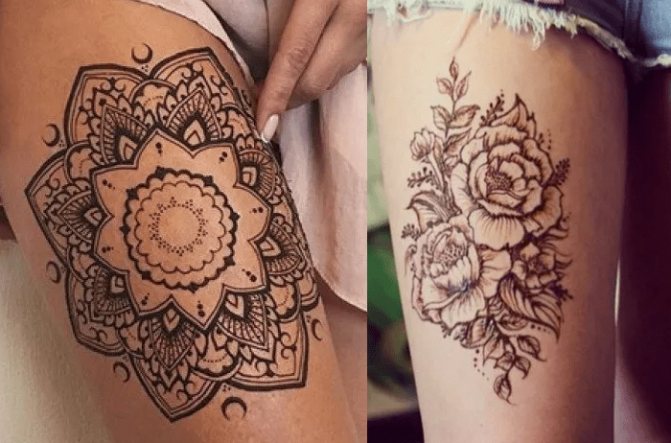

The left thigh is preferred by self-confident people. Such owners have a clear plan of action, helping to come to the goal, to achieve the desired.
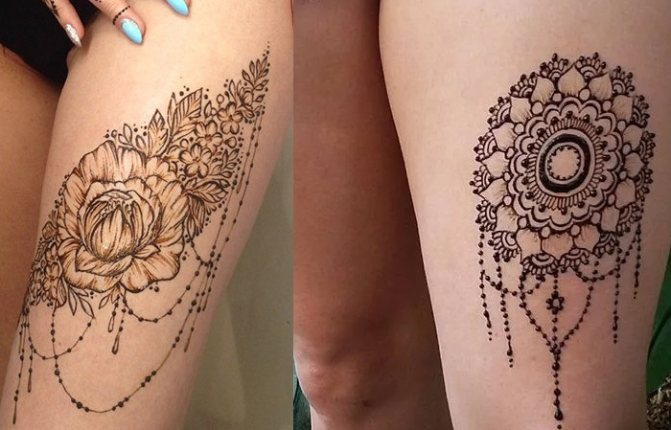

On the calf
The left calf is chosen by goal-oriented people with high self-esteem. They know what they want out of life, independent of the opinions of others. The choice of the right calf has no specific meaning, the interpretation of the images depends only on their content.
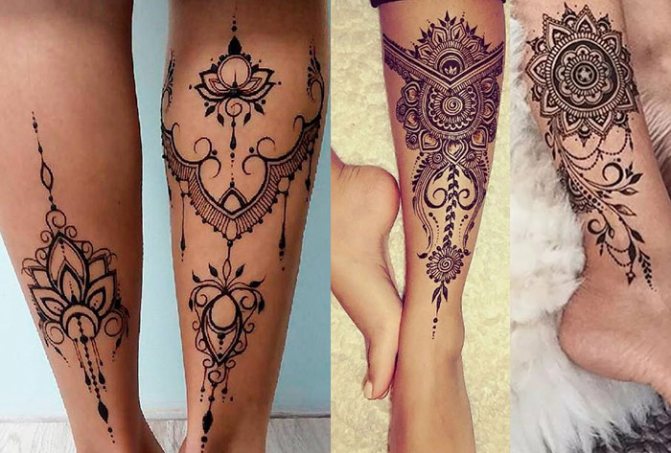

On the ankles and feet
The right foot pattern is made by a selfish, willful person. If the pattern is made by a woman, she shows men that she is going to use their attention and interest.
The left foot is preferred by unsure of themselves. These people need protection and guidance, they want to see a strong leader by their side.
Mehendi patterns on the ankles do not have a sacred meaning, they are used only as decoration.
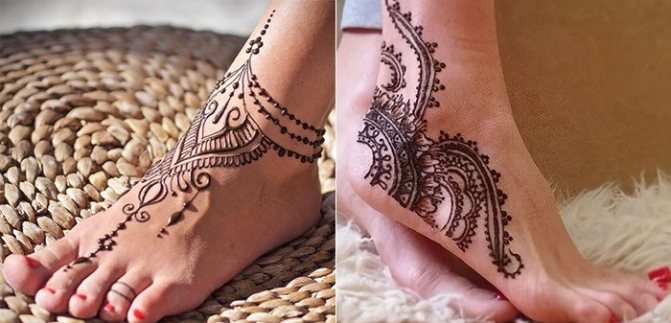

The henna inscriptions
One of the modern options for henna painting is to create an inscription on the body. Some girls do such painting to tell others about their inner world, their outlook or an important event. Others look out for a permanent tattoo and use henna as a way to "try on" a real tattoo.
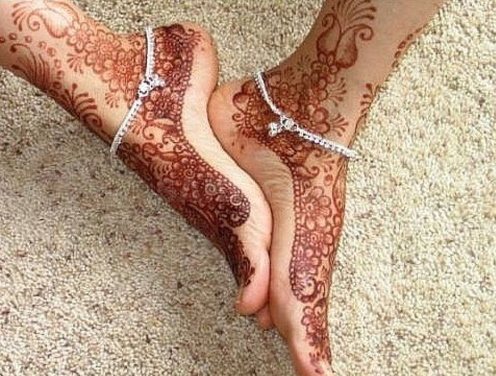

Unlike a real tattoo, a bio-tattoo does not last long, so you can write anything you want.
It is not uncommon to depict an inscription in the form of a hieroglyph. Also girls prefer not long inscriptions, but made in a beautiful font with lots of curls. Popular are also sayings in Latin.
The meaning of the tattoo
In the early days of its appearance, mehendi was a kind of amulet, a protective talisman on the body of a woman. It was applied solely for practical purposes:
- For protection against evil spirits;
- to communicate with the gods;
- attracting love, wealth and good fortune into her life.
As in many ancient cultures, plant and animal ornaments, each of which carries additional meaning, form the basis of mehendi painting. Among the most popular and having a special energetic power:
- mandala. This element represents the universe. Its main purpose is to harmonize all things. As a talisman mandala helps to discover hidden abilities, to order thoughts and emotions, to find a point of balance;
- om. The sign is identified with the beginning of Everything. One of the most ancient and mystical symbols. It combines well with other motifs and easily fits into large-scale pictures. It will be suitable for women who seek to know the truth and harmonize the inner world;
- Paisley, Indian cucumber or the tear of Allah. One of the most widespread symbols of both the ancient and modern world. In Indian interpretations, it is mentioned as a sign of spiritual energy and uninterrupted movement. In Middle Eastern countries.
means wealth and fertility. And the Egyptians symbolize the immortality of the soul. Suitable for girls who dream successfully marry and bear children. In men's compositions is perceived as a sign of happiness;
- Hamsa. Other names tattoo: hand of a god or the palm of Fatima. A henna tattoo in the form of a hand with a clenched little finger and thumb has a protective meaning. The figure protects the wearer from the evil eye and evil spirits. For married women, it helps to preserve family hearth and love. And women in the pregnancy, choose it as an additional protection for the unborn child. Sometimes a half-open palm is depicted with an inscribed eye;
- The lotus is another classic Indian symbol. Since ancient times, lotuses have been used to communicate with the gods. The flower applied to the body promotes finding the meaning of life. It is recommended for pregnant women as a female tattoo;
- Spiral. Most often, the spiral is depicted as a dream catcher. The tattoo is suitable for people engaged in yoga, as it promotes disclosure of internal energy and activation of the chakras.
Rather popular are temporary tattoos with images of Ganesha, who brings good luck in all affairs. This symbol is especially suitable for students and everyone who is looking for new knowledge. Creative people prefer to draw peacocks. The meaning of mehendi tattoos with this bird is quite multifaceted. Peacocks represent immortality, joy and celebration. They help to find inspiration.
How long does it take for the henna to dry?
After the drawing has been applied, it is necessary to wait for the henna to dry completely. Preferably, the drying process takes place in heat. You can accelerate the drying process of henna in the sun or with a hair dryer. On average the drawing dries up completely in 1 hour, but its intensity depends on how long the dried crust lasts.
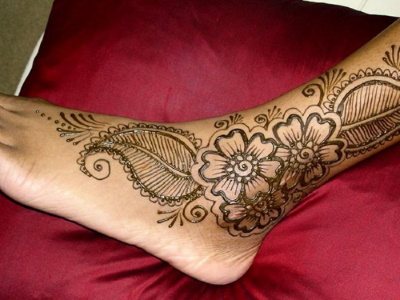

It is advised to leave the pattern to dry for 5-8 hours to get the best result. Therefore, henna patterns are often made in the evening, before going to bed. To fix the result, the skin with a pattern sprinkled with hairspray without alcohol and wrap this area of the food film.
How to remove a henna tattoo
Mehendi on the leg will gradually become paler and this process is not uniform, which may make you want to wash off the rest of the pattern as soon as possible. Regular contact with water and washing with soap (antibacterial soap is recommended) speeds up the process of washing the dye.
Using a hot bath will steam the skin, and washing with a washcloth will remove the absorbed dye residue. Girls who regularly go to the pool may notice that the paint comes off faster. This happens because of the high chlorine content in the water.
Mehendi sketches on the arm for beginners
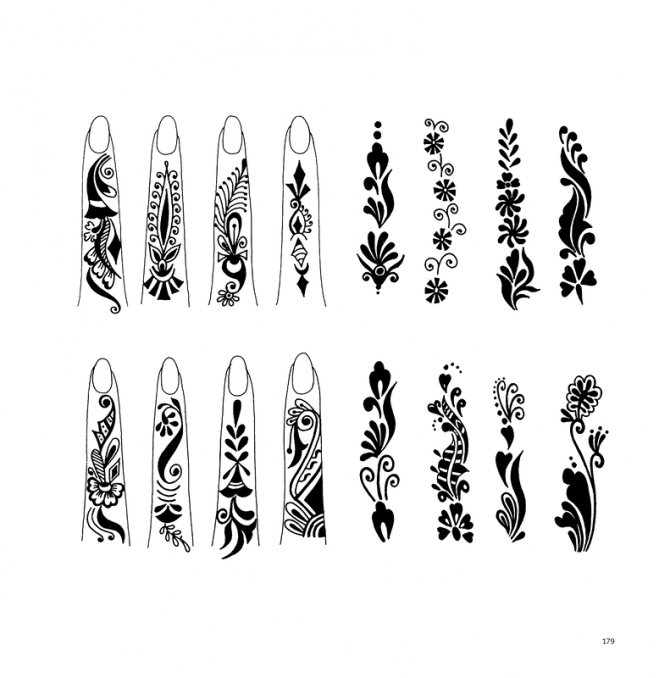

Mehendi Sketches on the Arm for Beginners
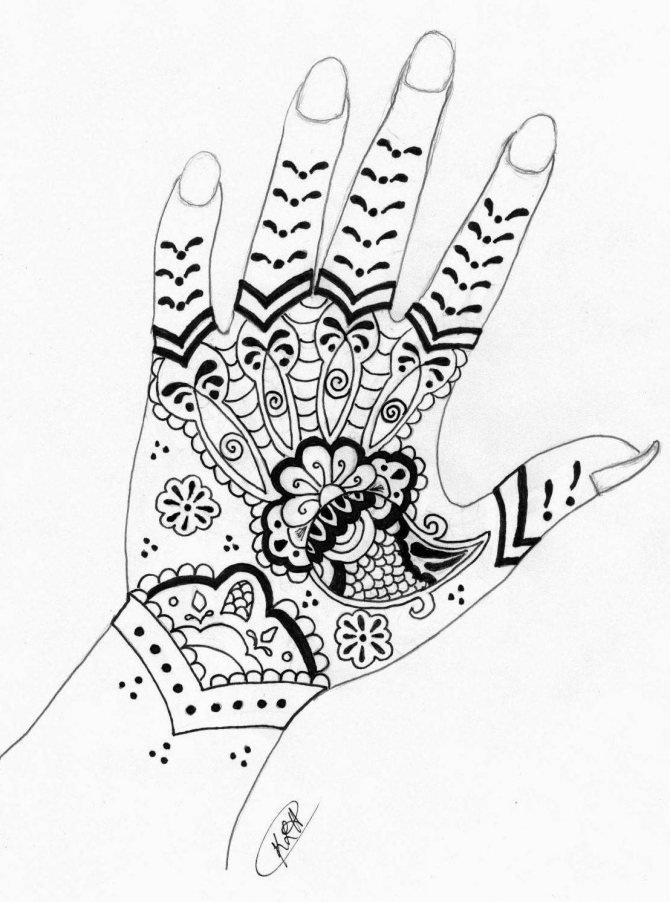

Sketches of mehendi on hands for beginners Sketches of mehendi on hands for beginners
